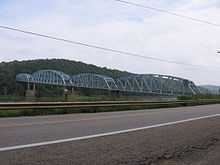Parker, Pennsylvania
| Parker, Pennsylvania | |
|---|---|
 | |
| Nickname(s): Smallest City in the U.S.A. | |
 | |
 | |
| Coordinates: 41°5′39″N 79°40′58″W / 41.09417°N 79.68278°WCoordinates: 41°5′39″N 79°40′58″W / 41.09417°N 79.68278°W | |
| Country | United States |
| Commonwealth | Pennsylvania |
| County | Armstrong County |
| Settled | 1797 |
| Incorporated | 1873 |
| Government | |
| • Mayor | William R. McCall. Jr. |
| Population (U.S. Census Estimate, 2010) | |
| • Total | 840 |
| Time zone | EST (UTC-5) |
| • Summer (DST) | EDT (UTC-4) |
Parker is a city located in Armstrong County, Pennsylvania, United States. It is located in the extreme northwestern portion of the county. The population was 840 at the 2010 census. The city was named for Judge John Parker, a lead surveyor of Lawrenceburg and founder/owner of Parker's Landing, the two villages which were combined to create Parker.
Parker is sometimes referred to as the "Smallest City in the U.S.A.". Parker was incorporated as a city on March 1, 1873 by special state legislation in the midst of the northwestern Pennsylvania oil boom. The new municipality was called "Parker" and was made up of the earlier villages of Parker's Landing (on the Allegheny River) and Lawrenceburg (on the bluff above the river). Residents assumed that Parker would quickly become a major population center, and, at the height of the oil boom, the population of Parker grew to over 20,000. The boom quickly went bust, however, and by the 1880s the "city" returned to its historic, small village size, and a population of approximately 1,000.
Transportation
- Roads
- Waterways
The Allegheny River, at this point is not used to transport goods and materials, but is still a navigable waterway for boating. The first lock (Allegheny River Lock and Dam No. 9) is located south of Parker, just past the borough of East Brady.
Geography
Parker is located at 41°5′39″N 79°40′58″W / 41.09417°N 79.68278°W (41.094151, −79.682771)[1].
According to the United States Census Bureau, the city has a total area of 1.1 square miles (2.8 km2), all of it land.
Demographics
| Historical population | |||
|---|---|---|---|
| Census | Pop. | %± | |
| 1880 | 1,835 | ||
| 1890 | 1,317 | −28.2% | |
| 1900 | 1,070 | −18.8% | |
| 1910 | 1,244 | 16.3% | |
| 1920 | 1,188 | −4.5% | |
| 1930 | 902 | −24.1% | |
| 1940 | 976 | 8.2% | |
| 1950 | 979 | 0.3% | |
| 1960 | 945 | −3.5% | |
| 1970 | 843 | −10.8% | |
| 1980 | 808 | −4.2% | |
| 1990 | 853 | 5.6% | |
| 2000 | 799 | −6.3% | |
| 2010 | 840 | 5.1% | |
| Est. 2012 | 838 | −0.2% | |
| Sources:[2][3][4] | |||
As of the census[3] of 2000, there were 799 people, 309 households, and 221 families residing in the city. The population density was 728.6 people per square mile (280.5/km²). There were 356 housing units at an average density of 324.6 per square mile (125.0/km²). The racial makeup of the city was 98.12% White and 1.88% African American.
There were 309 households out of which 32.4% had children under the age of 18 living with them, 58.9% were married couples living together, 8.7% had a female householder with no husband present, and 28.2% were non-families. 25.2% of all households were made up of individuals and 15.9% had someone living alone who was 65 years of age or older. The average household size was 2.59 and the average family size was 3.09.
In the city the population was spread out with 26.0% under the age of 18, 10.1% from 18 to 24, 26.0% from 25 to 44, 21.2% from 45 to 64, and 16.6% who were 65 years of age or older. The median age was 36 years. For every 100 females there were 95.4 males. For every 100 females age 18 and over, there were 89.4 males.
The median income for a household in the city was $29,844, and the median income for a family was $35,250. Males had a median income of $28,750 versus $21,875 for females. The per capita income for the city was $14,627. About 10.2% of families and 9.8% of the population were below the poverty line, including 9.7% of those under age 18 and 9.0% of those age 65 or over.
References
- ↑ "US Gazetteer files: 2010, 2000, and 1990". United States Census Bureau. 2011-02-12. Retrieved 2011-04-23.
- ↑ "Census of Population and Housing". U.S. Census Bureau. Retrieved 11 December 2013.
- ↑ 3.0 3.1 "American FactFinder". United States Census Bureau. Retrieved 2008-01-31.
- ↑ "Incorporated Places and Minor Civil Divisions Datasets: Subcounty Resident Population Estimates: April 1, 2010 to July 1, 2012". Population Estimates. U.S. Census Bureau. Retrieved 11 December 2013.
External links
| |||||||||||||||||||||||
| ||||||||||||||||||||||||||||||||||||||||||||||||

